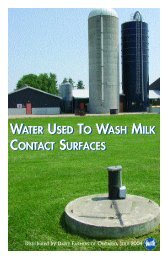Canadian Quality Milk On-Farm Food Safety Program - Centre ...
Canadian Quality Milk On-Farm Food Safety Program - Centre ...
Canadian Quality Milk On-Farm Food Safety Program - Centre ...
You also want an ePaper? Increase the reach of your titles
YUMPU automatically turns print PDFs into web optimized ePapers that Google loves.
<strong>Canadian</strong> <strong>Quality</strong> <strong>Milk</strong><br />
Table 12: Cooling Efficiency Guidelines<br />
PRE-COOLING<br />
Stage<br />
Temperature Range<br />
33°C (92°F) to 15°C to 21°C (60°F to 70°F)<br />
1 ST MILKING • 10°C (50°F) within 1 hour<br />
• Greater than 0°C and less than or equal to<br />
4°C (34°F to 40°F) within 2 hours ⎯ ½ hour<br />
preferred<br />
2 ND & SUBSEQUENT MILKINGS • Blend temperature should never go above<br />
10°C (50°F) for longer than 15 consecutive<br />
minutes<br />
IDEAL STORAGE<br />
AT PICK-UP<br />
• Greater than 0°C and less than or equal to<br />
4°C (34°F to 40°F) within 1 hour ⎯ ½ hour<br />
preferred<br />
• 2°C to 3°C (36°F to 38°F)<br />
• Great than 0°C and less than or equal to<br />
4°C (34°F to 40°F)<br />
Measuring Options:<br />
*Please note that these parameters do not apply to robotic milkers.<br />
1. Tank Thermometer: You have an accurate, operating bulk tank thermometer<br />
(accurate within ±1°C) and use the bulk tank thermometer’s read-out to measure<br />
the temperature of the milk after each milking. You then permanently record the<br />
temperature and initial the record. Since the temperature may be taken directly<br />
after milking, the milk may not be greater than 0ºC and less than or equal to 4ºC;<br />
however, you must determine what temperature is normal for your system at the<br />
time the temperature is regularly taken. Furthermore, you must make sure that<br />
this “normal” temperature is indicative of a validly working system. The<br />
temperature must be taken at the same time during the post-milking procedure<br />
every day.<br />
OR<br />
2. Basic Time Temperature Recorder: You use a Time Temperature Recorder to<br />
measure the temperature of the milk after each milking. If the recorder does not<br />
have any alarms or has basic alarms (alarm system has ‘nuisance’ alarms, e.g.<br />
cooling alarm goes off when tank is empty or washing), you must open the face<br />
plate of the recorder and initial the chart (or similar method) to prove that you<br />
have checked the temperature. If the recorder is of a digital design, then you<br />
must manually record the temperature and initial the record or log on the system<br />
and insert a note proving that you checked the temperature after each milking.<br />
June 2010 6—3
















